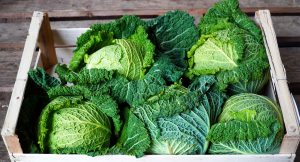In this article I have explained How to Grow Cabbage from Seed to Harvest which helps every farmer and home gardener to gain the knowledge on
- Available verities of Cabbage.
- Seed germination time.
- Suitable soil and weather conditions.
- Field preparation and planting distance.
- Fertilizer and Water Management.
- Required seed per acre and expected yield per acre.
Cabbage (Brassica oleraceae var. capitata) is one of the most important winter vegetables. The Portuguese introduced this crop to India. Later it gained importance during the rule of the British. Its leaf cabbage is an economically important component.
The cabbage has many small and large leaves like a bud, covered in layers of leaves one on top of the other. Cabbage is used not only as a vegetable but also as a salad. Cabbage has a unique smell due to the presence of glucoside sinigrin.

Current Cultivation Problems:
- Cost of seeds is high
- Lack of technical knowledge of farmers
- Pest problems are high
- Excessive (indiscriminate) use of pesticides
Failure of farmers to follow comprehensive management and comprehensive crop protection measures
While cultivating the cabbage crop, the varieties should be selected according to the climatic conditions, water supply, market facilities, resistance to insects and pests, high yield and the tastes of he consumers of the respective areas.
Short Term Types:
Golden Acre: Selected from the Copenhagen market category, the cabbage are small, round and weight 10 to 1.5 kg. It is harvested in 60-70 days after planting and the outer leaves are cup-shaped. Late harvesting can cause the cabbage to crack, so cuttings should be harvested within 10 days of preparation.
Pride of India: Cabbage size ranges from 1.5-2.0 kg. Slightly harder than Golden Acre.
Pusamukta (Option – 8): This verity cabbage can yields up to 23 tonnes per acre within 65-70 days of planting.
Copenhagen Market: Cabbage weigh 2.0 to 2.5 kg. The leaves are long and very broad. Everything is like an acre of gold.
Express: Same as Golden Acre, although it will be harvested earlier.
Hariranigol: Hybrid variety released by Mahiko Company. Cabbage is large, green in color, weighing 1.5-2.0 kg. The crop should be harvested within 95 days of planting. The yield is 22-24 tonnes per acre.
Mid Term Varieties:
Glory of Enquin: Harvest 80-90 days after planting. The cabbage is round and weigh 2-5 kg.
September: A variety suitable for cultivation in the Nilgiri hills. Their weight is 3-5 kg. This variety remains intact even after cutting.
Long term varieties:
Poosadam Head: Varieties selected from Katown Research Centre. Harvests quickly. The cabbage is pulpy and weigh approximately 3-5 kg. The outer leaves are light green in color and the middle leaves are clearly visible.
Late Drumhead: Harvest within 110-116 days. Lumps are large and loose. Apart from that, farmers are cultivating many varieties released by private companies (BIS-150, BIS-126, Nath Lakshmi, Green Express, Green Boy, Shree Ganesh Gol, Sona, Shweta, Avanti, Quiso, Meenakshi, BC-76, Indu, Green Challenge etc).
Soils:
Black alluvial soils with good drainage are suitable for cabbage cultivation. Soils with a Soil PH levels 5.5–6.5 are suitable.
Seed rate:
10 Grams of seeds Contains approximately 2000 seeds
Straight varieties: 280-320 gm per acre.
Hybrid varieties: 120-200 g per acre.
Crop season:
Short-duration varieties: July-August
Medium-duration varieties: September
Long-duration varieties: October-November
Main field preparation:
The field should be plowed 3-4 times until it is well covered.
After leveling well, drains and pits should be made at a distance of 60 cm.
4-6 weeks of old seedlings should be planted in the field with water.
Planting distance:
Short duration varieties: 60×30 cm. or 45×45 cm.
Intermediate varieties : 60×45 cm.
Perennial varieties : 60×60 cm.
Water management:
Water should be applied immediately after planting. Water should be applied once in 10 days in black soils and once in 6 days in light soils.
Watering should be stopped before harvesting the tubers. When we continue watering while harvesting period it may cause the splitting or bursting of cabbage heads. Water management in cabbage must be practiced for good yield.
Fertilizer management:
200 kg with 8-10 tones of cattle manure per acre last fall.
Yield:

Straight varieties: 8 tons / acre
Hybrid varieties : 20 tons / acre
